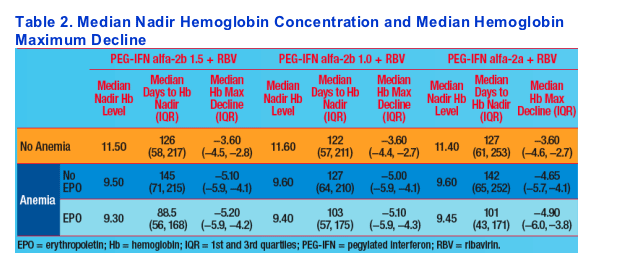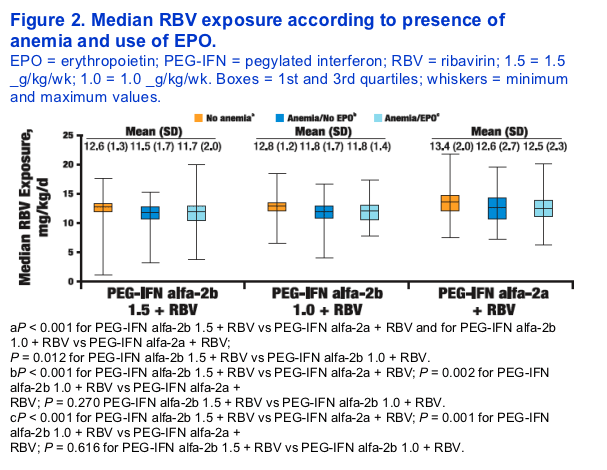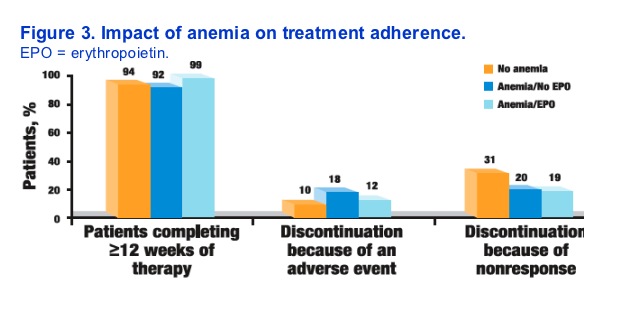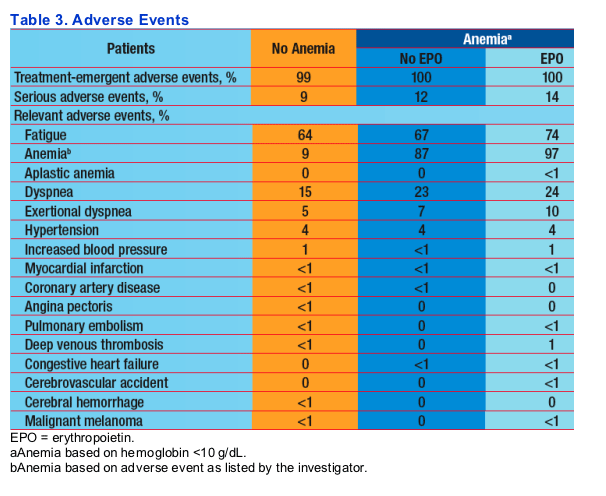 |
 |
 |
| |
Treatment-Related Anemia Is Associated With Higher SVR Rates Among Persons Treated With Peginterferon (PEG)/Ribavirin (RBV): Results From the IDEAL Study
|
| |
| |
Reported by Jules Levin
AASLD Nov 4 2008 San Francisco, CA
Mark Sulkowski,1 Mitchell L. Shiffman,2 Nezam H. Afdhal,3 K. Rajender Reddy,4 Weiping Deng,5 Stephanie Noviello,5 Janice K. Albrecht,5 and John G. McHutchison6 on Behalf of the IDEAL Study Team
1Johns Hopkins University School of Medicine, Baltimore, MD, USA; 2Virginia Commonwealth University Medical Center, Richmond, VA, USA; 3Beth Israel Liver Center, Boston, MA, USA; 4University of Pennsylvania Health System, Philadelphia, PA, USA;
5Schering-Plough Research Institute, Kenilworth, NJ, USA; 6Duke Clinical Research Institute, Durham, NC, USA
AUTHOR CONCLUSIONS
Patients with anemia were significantly more likely to attain end-of-treatment response and SVR than were those without anemia, despite having received less RBV (mg/kg/d) during treatment after the development of anemia
Among patients with anemia, EPO use was associated with a lower adverse event-related
discontinuation rate and a higher on-treatment viral response rate but not with a substantially higher SVR rate
Although potential selection bias for comparing the nonrandomized groups may exist, these data suggest that other host and treatment factors (eg, plasma or hepatocyte RBV concentration) contribute to higher rates of viral response in patients who develop anemia
These data support the hypothesis that treatment-related anemia may be a pharmacodynamic marker of patient exposure to the active moiety, RBV triphosphate
Further modeling is under way to assess the role of EPO in this study
ABSTRACT
Background: Anemia due to peginterferon/ribavirin (PEG/RBV) affects about 30% of persons treated. Epoetin alfa (EPO) has been used to increase hemoglobin (Hb) levels to improve quality of life and RBV dose. The relationship of anemia, EPO use, and sustained viral response (SVR) is unknown.
Methods: 3070 HCV genotype 1-infected patients (pts) were randomized (1:1:1) and treated for 48 weeks with PEG 2b 1.5 μg/kg/wk or PEG 2b 1.0 μg/kg/wk + RBV 800-1400 mg/d, or PEG 2a 180 μg/wk + RBV 1000-1200 mg/d. Patients with virologic failure at treatment week (TW) 12 or 24 stopped therapy. Anemia
was defined as Hb <10 g/dL. Anemic patients underwent protocol-defined RBV dose reduction, after which EPO was permitted at investigator discretion. Viral response rates (ITT) were assessed in 3 groups:
1) No anemia; 2) Anemia/No EPO; 3) Anemia/EPO.
Results:
No anemia was observed in 2158 pts (70%), of whom 67% were male and 83% were older than 40 years; median Hb maximum decline was _3.60 g/dL.
Anemia was observed in 865 pts (28%), of whom 41% were male and 90% were older than 40 years; median Hb maximum decline was _4.65 to _5.20 g/dL. EPO was used in 449 (52%) anemic pts. Median nadir Hb level and median Hb maximum decline were similar in anemic pts with and without EPO use.
Median RBV exposure (mg/kg/d) during treatment: (PEG 2b 1.5/PEG 2b 1.0/PEG 2a, respectively) - No anemia, 12.6/12.6/13.5, Anemia/No EPO, 11.7/12.0/12.6, Anemia/EPO, 11.9/11.9/12.5.
The proportion of pts completing ≥12 weeks of therapy: No anemia, 94%; Anemia/No EPO, 92%; Anemia/EPO, 99%.
Discontinuation due to adverse events (AEs)/virologic nonresponse: No
anemia, 10%/31%; Anemia/No EPO, 18%/20%; Anemia/EPO, 12%/19%.
End-of-treatment, relapse, and SVR rates are shown in Figure 4. P-value < 0.0001 using Mantel-Haenszel test for the association of Anemia with SVR adjusting for treatment.
Conclusions: Compared to those with no anemia, anemic pts were less likely to have virologic nonresponse and significantly more likely to achieve SVR despite receiving less RBV (mg/kg/d) during treatment. Although potential selection bias for comparing the groups may exist, this suggests that other host and treatment factors (e.g., plasma RBV concentration) contribute to viral response in this group. Among anemic pts, EPO use was associated with lower AE-related discontinuation and higher on-treatment viral response but not a substantially higher SVR rate.
Note: Abstract has been updated since submission.
Background
Standard of care for patients with chronic hepatitis C is pegylated interferon (PEG-IFN) alfa-2b (PegIntron; Schering-Plough) + ribavirin (RBV) or PEG-IFN alfa-2a (Pegasys; Roche) + RBV
-- With these treatments, patients infected with hepatitis C virus (HCV) genotype 1 (G1) attain sustained virologic response (SVR) rates of 42% to 46%1,2
Although these treatments are efficacious, they are associated with unwanted side effects
Hemolytic anemia is a well-described side effect of RBV that can lead to dose reductions and treatment discontinuations, potentially resulting in lower rates of SVR3
-- Erythropoietin (EPO) supplementation helps maintain RBV dose levels and improves patient quality of life4,5
EPO use was evaluated in the Individualized Dosing Efficacy vs Flat Dosing to Assess Optimal Pegylated Interferon Therapy (IDEAL) study
-- IDEAL investigated the efficacy and safety of weight-based PEG-IFN alfa-2b + weight-based RBV and fixed PEG-IFN alfa-2a + semi-weight-based RBV in patients with chronic hepatitis C caused by HCV G1 infection6
Aim
To evaluate the relationship between anemia and the use of EPO and their impact on SVR in the IDEAL study
Patients and Methods
Patients
-- Chronic hepatitis C, genotype 1 ⋅ Weight, 40 to 125 kg
-- Treatment naive ⋅ Compensated liver disease
-- Age, 18 to 70 years
Study Design
IDEAL was a phase 3b, randomized, parallel-arm trial conducted at 118 academic and community centers in the United States (Figure 1)
-- PEG-IFN alfa-2b was administered as double-blind treatment, and PEG-IFN alfa-2a and RBV were administered as open-label treatments

Patients had their treatment discontinued for therapeutic failure, defined as:
-- <2 log10 decrease from baseline in HCV RNA at treatment week (TW) 12
-- ≥2 log10 decrease from baseline in HCV RNA that remained detectable at TW 12 and detectable HCV RNA at TW 24
Per protocol, anemia was defined as a decrease in hemoglobin level to <10 g/dL. After anemia developed, patients were required to reduce the RBV dose according to the protocol-defined 1-step (PEG-IFN alfa-2a) or 2-step (PEG-IFN alfa-2b) schema. At the discretion of the site investigator and the patient, EPO use was permitted (but not provided by the study) after RBV dose reduction. Patients were permitted to increase the RBV dose after correction of anemia
RBV dose reduction in the PEG-IFN alfa-2b + RBV arms
-- Decrease from full dose of 800-1200 mg/d by 200 mg (first dose reduction) and then by 200 mg (second dose reduction), or
-- Decrease from full dose of 1400 mg/d by 400 mg (first dose reduction) and then by 200 mg (second dose reduction)
RBV dose reduction in the PEG-IFN alfa-2a + RBV arm
-- Decrease from full dose of 1000-1200 mg/d to 600 mg/d (per prescribing information)
Assessments
Hemoglobin concentrations were assessed at TWs 2, 4, 8, 12, 18, 24, 30, 36, 42, and 48/end of treatment and follow-up weeks 4, 12, and 24
HCV RNA levels were assessed at TWs 2, 4, 12, 24, and 48/end of treatment and follow-up weeks 4, 12, and 24
-- HCV RNA was measured using COBAS TaqMan (Roche; lower limit of quantitation, 27 IU/mL)
-- SVR was defined as HCV RNA <27 IU/mL at the end of follow-up (week 24 or, if missing, week 12)
Study centers recorded EPO use throughout the study period
Results
Patient Characteristics
Patients (n = 3070) had similar characteristics across the 3 treatment groups (see Poster 1850, 1868, or 1869 for characteristics by treatment group)
Differences between patients who did not develop anemia and those who developed anemia with or without EPO use during treatment are shown in Table 1

No anemia was observed in 2158 of 3070 (70%) patients
-- 83% were older than 40 years
-- Baseline mean and median hemoglobin concentrations were higher than in patients who developed anemia
Anemia was observed in 865 of 3070 (28%) patients
-- 59% were female
-- 90% were older than 40 years
EPO was used in 449 of 865 (52%) patients who developed anemia

RBV Exposure
During treatment, median and mean RBV exposures were higher among patients receiving PEG-IFN alfa-2a than among those receiving PEG-IFN alfa-2b, regardless of EPO use and development of anemia (Figure 2)

Impact of Anemia on Treatment Adherence
Fewer patients with anemia completed ≥12 weeks of therapy (Figure 3); this effect of anemia was reversed by the use of EPO (P < 0.001 for No Anemia or Anemia/No EPO vs Anemia/EPO)
More patients who developed anemia that was not treated with EPO discontinued treatment because of an adverse event than did patients who did not develop anemia (P < 0.001 for No Anemia vs Anemia/No EPO; Figure 3); this effect of anemia was reversed by the use of EPO (P = 0.017 for Anemia/No EPO vs Anemia/EPO)
The discontinuation rate because of virologic nonresponse at TWs 12 and 24 was highest among patients who did not develop anemia (Figure 3) (P < 0.001 for No Anemia vs Anemia/No EPO and Anemia/EPO)

Virologic Outcomes
-- End-of-treatment response, relapse, and SVR rates are shown in Figure 4
-- P < 0.0001 using Mantel-Haenszel test for the association of anemia with SVR adjusting for treatment


REFERENCES
1. Manns MP et al. Lancet. 2001;358:958-965.
2. Fried MW et al. N Engl J Med. 2002;347:975-982.
3. Nomura H et al. J Gastroenterol Hepatol. 2004;19:1312-1317.
4. Afdhal NH et al. Gastroenterology. 2004;126:1302-1311.
5. Pockros PJ et al. Hepatology. 2004;40:1450-1458.
6. McHutchison J et al. J Viral Hepat. 2008;15:475-481.
|
| |
|
 |
 |
|
|